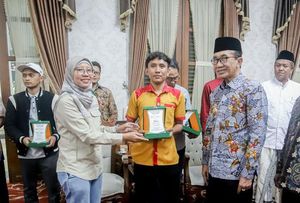As the sun rises on April 10, 2025, puzzle enthusiasts are gearing up for another round of the New York Times Connections game. This daily brain teaser has captivated players with its unique challenge of finding common threads among seemingly unrelated words. Today's puzzle, designated as #669, promises to keep players on their toes with a mix of themes that require keen observation and quick thinking.
The game operates on a simple premise: players must group 16 words into four categories, each containing four words that share a common theme. The categories vary in difficulty, color-coded from yellow (easiest) to purple (hardest). As players engage with the game, they can share their results on social media, creating a sense of community among fans.
For those seeking a little guidance, today's hints are here to help navigate the tricky waters of Connections. The yellow category features shades of yellow, while the green category revolves around the concept of supply. The blue category taps into the anti-spirit of Christmas, and the purple category delves into Spanish words. With these themes in mind, players can begin to make connections that might not be immediately obvious.
As the game unfolds, players are met with words such as CANARY, GOLD, LEMON, and MUSTARD in the yellow category, representing various shades of yellow. Meanwhile, the green category includes MINE, RESERVE, STORE, and WELL, all terms associated with supplies and resources. The blue category, which might stump some, features BAH, COAL, GRINCH, and NAUGHTY, all linked to the less cheerful aspects of the Christmas season. Finally, the purple category presents ELLA, GUSTO, MAYO, and SOY, all common words in the Spanish language.
For many, the challenge lies not only in identifying the correct groupings but also in navigating the potential red herrings that may lead players astray. The game encourages critical thinking and creativity, as players must consider various interpretations of words and phrases.
Connections has gained popularity for its engaging format, reminiscent of other word games like Wordle. The Times credits associate puzzle editor Wyna Liu with the game's creation, which has since become a staple in the publication's Games section. Players can enjoy Connections on both web browsers and mobile devices, making it accessible for anyone looking to sharpen their word skills.
As the clock ticks closer to midnight, players eagerly anticipate the next puzzle, knowing that each day brings a fresh set of challenges. The excitement of discovering new themes and words keeps the game dynamic and engaging, with players returning day after day.
For those who prefer a little nudge in the right direction, the hints provided can be invaluable. They offer a glimpse into the connections that may not be immediately apparent, allowing players to refine their strategies and enhance their gameplay. With hints like "These are technically all the same colour" for the yellow category and "Think of Scrooge" for the blue category, players can use their knowledge and intuition to piece together the puzzle.
Despite the challenges, players often find satisfaction in solving the puzzle, whether they do so independently or with a little help from hints. The thrill of completion, coupled with the joy of learning new words and associations, makes Connections a rewarding experience.
As the day progresses, puzzle fans will look back on today's Connections as a testament to their word skills and problem-solving abilities. Whether they managed to solve the puzzle on their own or relied on hints, the experience is what truly matters.
In the end, Connections is more than just a game; it's a celebration of language, creativity, and community. So, as players wrap up today's puzzle, they can take pride in their efforts and look forward to the next challenge awaiting them at midnight. The journey through words continues, and with each new puzzle, the excitement only grows.










